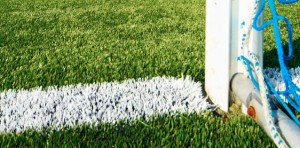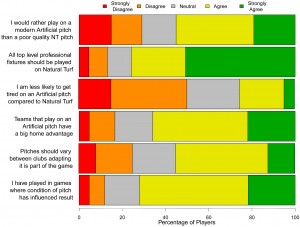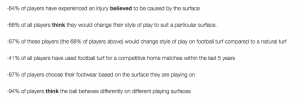Effects on Playing Style and Perceptions
Written in 2015 by Raya Islam
Return to Turf Controversy main page
Introduction
The Women’s 2015 World Cup in Canada brings about some drama never brought about in the world of soccer. The controversy involving the use of turf at the Women’s World Cup has met a great deal of backlash from multiple sides of the argument. Players despise the idea of competing on artificial turf, and after losing the court case against FIFA, cannot do much more about it. Although the case was filed as a violation of the “Human Rights Code” of Ontario, [espn] its implications have led to a variety of discussions. There exists several types of turf and each player has played on a variety of turf fields. The fields being used for the Women’s World Cup are, according to FIFA, the highest quality, third generation turf. A majority of the resarch done with turf is focused on the first and second generation types, but opinions and analyses exist with the latest kind. FIFA is very open about their quality checks of the turf being implemented in this world cup, as well as why they are so adamant about using it despite the layers pleas for change.
One of the major complaints players have on top of their negative perceptions of the surface is the effects turf has on playing style of soccer. The alterations of playing style on turf versus on natural grass are advocated for by players and researched by scientists across the globe.
Picture from a 2008 study by FIFA-hired company Prozone denying major
differences in Playability of FieldTurf and natural grass [14]
Perception vs. Reality
Since the perceptions players have about the turf are brought up regularly, several scientific studies have been conducted to look at the factual evidence behind these complaints. Does turf truly alter the way the game is played? With the additional injuries caused by turf in an already dangerous game, different studies show similar evidence about the playing style on turf. While most opinions state that a field’s playing surface has a huge impact on the feel of the game with faster ball movement and cleaner passes on turf, [4] FIFA sports medicine expert Jan Ekstand claims that “Perception is one thing and reality is another.” [10] Ekstan’s bold statement makes you think again about why this controversy is going on in the first place.
According to studies done by FIFA and studies outside of FIFA, the actual movement of the ball does not change much, but the mindset of the players has a greater change on the game as opposed to the ball. However, there still exists obvious alterations in the playing field and FIFA has a tendency to ignore these thoughts. Since the most recent type of turf is being implemented, players are unfamiliar with it, causing even more discomfort. Players feel as if this “inferior surface” [post] causes the players to feel like ‘guinea pigs’ to the idea of turf surfaces at the World Cup level. This is the first World Cup to ever use turf for all competition and training fields.
The misconception is that the turf being used is like the turf people are used to seeing, however FIFA claims that the turf used for this tournament is the latest “third generation” surface, whereas most of the turf research has been performed on first and second generation surfaces. When FIFA openly states that more research with the perceptions of turf have to be done, it makes the initial implementation of turf on the international stage slightly premature [10].
The Science Behind It
An in-depth study in Sweden [14] analyzed the movement patterns, ball skills, and impressions of Swedish elite soccer players on artificial turf versus natural grass. Time motion and technical analyses were performed on 100 players. The researchers monitored the amount of high intensity running, number of sprints, tackles, and more on each surface. The first and second generation surfaces showed a difference in ball bounce and took a greater toll on the players. Several claimed they found it difficult to turn, stop, and start. The players stated that their general agility decreased. While the analysis of the video feeds showed little difference in time spent running, walking, sprinting and amount of long and short passes, the players perceptions did not match such findings. There were obvious alterations to playing style in the midfield. On the turf, there were more passes amongst the midfield and a significant decrease in slide tackles and headers. So while the locomotor skills were the same on both surfaces, the increase of passes in the midfield alter some of the movement amongst players and the lack of slide tackles changes the way the defense operates. With more pattern plays and possession in the midfield, the style of play was definitely altered, if only slightly, on the turf. A majority of the players attested to feeling more exhausted and sore afterwards.
Graphic from the Scout7 study on player perceptions of turf [12]
What does FIFA think of it all?
Another study conducted by FIFA articulates the advantages to turf and how “there is no significant difference in the overall incidence, severity, nature or cause of match or training injuries sustained [1].” Although the details of the study done in 2008 on 100 matches in the UEFA League are not published, FIFA has released statements from their lawyer, Eric Harrison, and and their sports medicine expert, Jan Ekstand, to support the turf movement in the Women’s World Cup. Harrison, who claims that “turf is integral to the Canadian World Cup [6],” details the in depth inspection process on installation, quality checks, and quality of construction. Under his speculations, installing natural grass is difficult in Canada because of the long winter recovery process. However, he consistently assures the readers that the artificial turf is compared to the standards of natural grass. His reiteration often hints at the superiority of natural grass over artificial turf. In his detail of the quality check process, he states that the turf used at this level is meant to move the ball at the same speed and that the ball should not bounce higher or lower at varying angles, all aspects vital to the style of play in soccer. Harrison tries to claim that the negative perceptions of turf are more associated with players’ experiences on lower level turf, none of which will be used in this world cup [6]. Jan Ekstand who performs soccer research in Sweden agrees that artificial turf is not popular among elite coaches and older players, but the academies are beginning to integrate it into the system from a young age [10]. In his opinion, the people with the greater complaints about turf effecting the playing style of soccer are motivated more by inexperience with the newer improved surface, and that this perception will be less apparent in the future.
While FIFA claims that turf was chosen for a variety of reasons in Canada, especially the weather, there is no evidence that Canada is incapable of maintaining grass for the four weeks of the tournament. FIFA’s study disagrees with the increased injuries caused by artificial turf versus natural turf, and “continues to conduct studies to gain greater insight into how perceptions have an impact and how they are evolving.”
What the Players Think
Every soccer player that has experienced turf has his or her two cents about the experience on the surface.
While the studies responsible for finding the physical effects in playing style caused by turf show slight changes in playing style from natural grass, scientific evidence cannot prove or disprove the plethora of player claims on each individual’s discomfort towards turf. The perception of the game on turf as “more physically taxing and technically demanding” is agreed upon by many players [13]. The court case filed by the soccer players formulated from claims marking the surface as one that “fundamentally alters” the way soccer is played [8]. Even if most of the negative remarks towards turf exist inside the mind of the player, why isn’t that enough for FIFA to install natural grass fields? These female players already know that they are exposed to a heightened risk of serious injury and they agree that their “dignity, state of mind, and self-respect would be devalued on this “second-class surface [8].”
Another study geared towards how the perceptions of players influences the play looked deeper into the psychology behind the entire situation. Through open ended unstructured interviews, researchers assessed the players’ personal requirements for a good surface and relate plater opinions with playing experiences. This study basically shows what we already know about the perceptions of the pitch [12].
Graph from the Scout7 study detailing player opinions of turf [12]
While players tend to analyze the surface more when artificial turf is being used, the difference is apparent in their minds. A large percentage of players agree that the conditions of the turf can definitely alter the game result. In the study that targeted over 1000 elite players in 44 countries, “66% of players think they should change their style of play to suit a particular surface.” and of those players, 67% of them would “change style of play on football turf compared to natural turf.” These astounding results do more than convey the issues with turf, they show that soccer, an extremely mental sport, is ruled by so much more than just training.
Statistics from the Scout7 study detailing player opinions of turf [12]
The idea that a significant level of adaptation is required by players at the most important sporting event for women’s soccer in the world is astonishing.
Famous USA Women’s Soccer player Abby Wambach explicitly states that “The game changes, the ball rolls faster, and it’s less fun as an athlete. It should be grass stains, not blood [3].” A majority of players agree that a grass surface leads to a more “natural” game [4], FIFA refuses to acknowledge the discrepancies. The players that were the forefront of the court case hate the idea that “the balls are harder to control” and “players are less likely to go for headers or slide tackles” all opinions justified in the previous scientific studies. These significant aspects of soccer contribute to the spectator aspect of the sport, especially women’s soccer which has a lot less flops than men’s soccer. Tackles and headers add to the excitement and aggression of soccer, but now the players feel obliged to act more reserved to lower the risk of injury. On top of that, the player are just more worn out at the end of the day. If the top, in-shape soccer players in the world playing on such a significant stage have to constantly worry about post-match soreness, knee abrasions, and more, of course that will alter the style of play [3]. When viewers begin to lose interest due to the decrease in unpredictability and aggression in the game, who’s to blame?
Who Likes Turf?
Turf does have its advantages in that is is adaptable to all conditions and easy to maintain. The grassroots movement of soccer in Canada enjoys the idea of turf given the year-round harsh weather conditions. With five of the six stadiums already installed with turf, Canada sees no problem with the situation. Since the complaint against the turf came in at a time super close to the World Cup, some Canadians see the tardiness as a contribution to why nothing was done to accommodate the women. While turf is good for Canada, Canadians need to remember that the World Cup is a competition to represent the best soccer in the world in a short period of time. Most of these strong opinions, however, stem from from a popular Canadian soccer blog that is the forefront in the grassroots movement of soccer [7].
Final Thoughts
While the two sides of the argument for turf have their validations, it all boils down to the clear statements that players are uncomfortable playing a sport so ingrained in their muscles. If multiple players from different studies repeatedly claim that they plan on altering the way they approach the game not because of tactics, but because of the surface, one should question where FIFA is coming from with their counterarguments. Regardless of the cost implications and efficiency involved with installing turf instead of grass, at the end of the day, this is the biggest sporting event in the world for Women’s Soccer at a time that it’s flourishing, too. This is the first World Cup where turf will be used, and not to mention that there are no intentions of using turf at the next Men’s World Cup. When FIFA’s lawyer Eric Harrison makes it clear that natural grass is the ultimate benchmark for these highest quality turf surfaces, then why not keep the natural grass? Is weather really the only factor, or is there something more? There are already so many mental games involved with the game of soccer, why add more?
[1] Wistel,Katharina. “FIFA Women’s World Cup 2015: Football Turf Q&A.” FIFA.com. web
[2] Kassouf, Jeff. “FIFA Official: Women’s World Cup on Turf, Case Closed.” Equalizer Soccer. 15 Jan. 2015. Web. 29 Apr. 2015.
[3] Geir, David. “Grass vs. Artificial Turf: Battle Heats up for Women’s World Cup.” Post and Courier. 02 Oct. 2014. Web. 29 Apr. 2015.
[4] Hall, Nora. “Grass vs. Turf: The Great Debate.” USSF. n.d. Web. 29 Apr. 2015.
[5] Andersson, Helena. “Elite Football on Artificial Turf Versus Natural Grass: Movement Patterns, Technical Standards, and Player Impressions.” Journal of Sports Scientists. Orebro University. 1 Oct. 2007. Web 29 Apr. 2015.
[6] “Harrison: Football Turf Is Integral to Canada 2015.” FIFA.com. 23 Oct. 2014. Web. 29 Apr. 2015.
[7] “CSA Opposes Women’s Turf Complaint.” Nuke Soccer. Nukestar, 11 Oct. 2014. Web. 29 Apr. 2015.
[8] Mccan, Michael. “Players’ Anti-turf Lawsuit for Women’s World Cup Not a Clear-cut Win.” SI.com. 31 Oct. 2014. Web. 29 Apr. 2015.
[9]“Grass vs. Artificial Turf.” YouTube. YouTube, 15 Oct. 2015. Web. 29 Apr. 2015.
[10] “Ekstrand: The Total Risk of Injury Is the Same on Football Turf as It Is on Natural Grass.” FIFA.com. 07 Nov. 2014. Web. 29 Apr. 2015.
[11] Shaerlaeckens, Leadner. “United States Drawn into Women’s World Cup Group of Death.” Foxsports.com. 6 Dec. 2014. Web. 29 Apr. 2015.
[12] Osei-Owusu, Paul. “Elite Players’ Perceptions of Football Playing Surfaces.”Scout7. 1 Aug. 2014. Web. 29 Apr. 2015.
[13] Williams, Jay. “Energy Cost of Playing on Artificial Turf.” The Science of Soccer Online. 8 Jan. 2011. Web. 29 Apr. 2015.
[14] “Turf Study Confirms “No Major Differences” in Playability of FieldTurf and Natural Grass.” TARKETT.COM. 2 Aug. 2008. Web. 29 Apr. 2015.





I have always preferred a natural surface! It is great to know that other athletes agree. And the number one consideration should always be the safety of the athlete from the athlete themselves all the way to the head of a big organization like FIFA!
I have always preferred a natural surface! It is great to know that other athletes agree. And the number one consideration should always be the safety of the athlete from the athlete themselves all the way to the head of a big organization like FIFA!